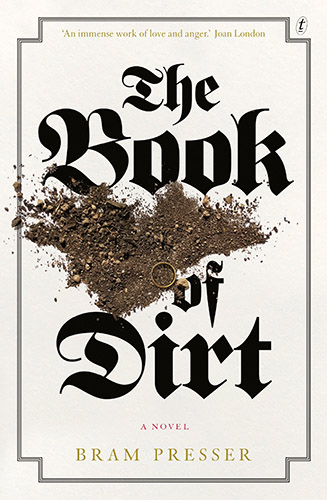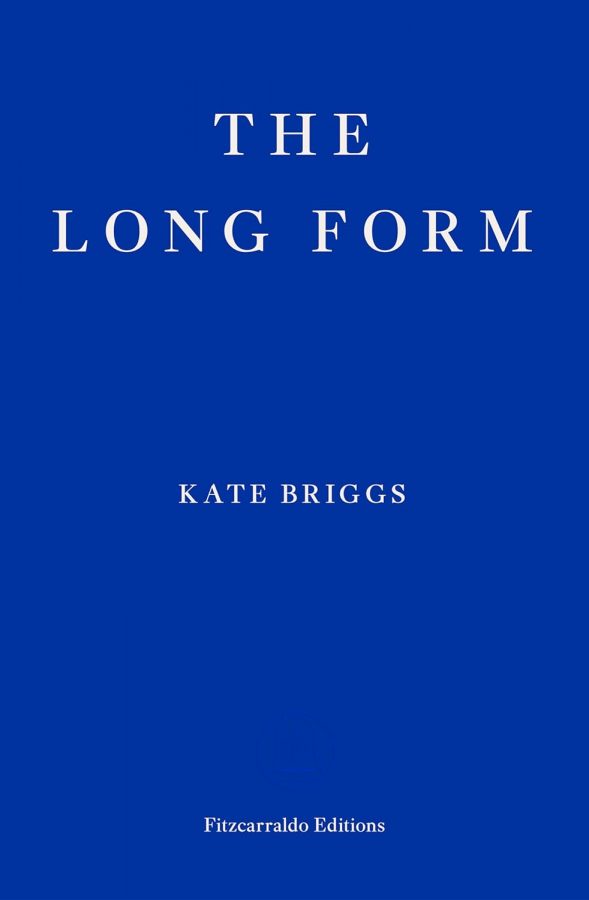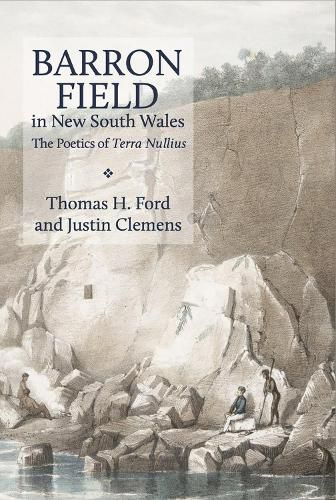In David Graeber’s Debt: The First 5,000 Years (2012), the anthropologist and activist asks, ‘How does it become possible to treat people as if they are identical?’ He is reflecting on how a human being can be turned into an object of exchange, a slave—this ‘requires first of all ripping her from her context; that is, tearing her away from that web of relations that makes her the unique conflux of relations that she is’.
Reading The Book of Dirt, a debut novel about the Holocaust by an Australian author, Bram Presser, I found myself returning to Graeber’s arguments about the transformation of humans into inhuman objects. Genocide and slavery are not identical, but both reduce human lives to an homogenous other, a thing that can be exploited or eradicated. In survivor accounts of Nazi concentration camps, or in fictional accounts of life inside them, this is what I find most chilling: human beings being brutally ripped from their context, from the unique conflux of relations that constitutes them; the narrative of their existence first dismantled, and then erased entirely.
This is also described in the work of the Polish philosopher Zygmunt Bauman, who in Modernity and the Holocaust (1989) identifies how Jewish people became ‘bureaucratic objects’ in Nazi Germany — how, when they are reduced ‘to pure, quality-free measurements, human objects lose their distinctiveness… It is only humans that may be objects of ethical propositions.’ This is exactly the sort of moral or ‘social death’ Graeber examines, referencing at length the sociologist Orlando Patterson’s Slavery and Social Death (1982).
Bauman and Patterson are just two of many modern thinkers on slavery and genocide. And herein lies the challenge: to write something new. Such events have been widely described and analysed. And yet, reading Graeber’s analysis is still shocking. It’s an unflinching, acute translation of something so alien to human experience into terms that show its ongoing relevance. If his work is confronting it’s a reminder to the reader that the past is not a strange and irrelevant place.
Such is the case with The Book of Dirt. As a work predominantly of fiction, its task is less explicit than that of Patterson or Bauman or Graeber: it attempts to reconstitute the experiences of Holocaust victims, and to negotiate their telling in the present. In interviews, Presser has described the weight of writing The Book of Dirt:
The weight I felt was not so much about documenting the unrecorded stories, but to consider the place and responsibility of the novelist in a post-survivor world. What is left to be told? … What right do we have to ‘invent’ stories when so many powerful books written by survivors—both fiction and nonfiction—already exist? What can the novelist hope to add to the words of Primo Levi or Elie Wiesel or Viktor Frankl?
At one point in the book, Presser the narrator speaks directly to this anxiety:
It is too late. What’s left to fill the silence is no longer theirs. This is my story, woven from the threads of rumour and legend, post-memory.
That last term, ‘post-memory’, is a reference to Marianne Hirsch’s The Generation of Postmemory: Writing and Visual Culture After the Holocaust (2012), which offers an answer to Presser’s question about what is left to be told:
At stake is precisely the ‘guardianship’ of a traumatic personal and generational past with which some of us have a ‘living connection’, and that past’s passing into history or myth. At stake is not only a personal/familial/generational sense of ownership and protectiveness, but an evolving ethical and theoretical discussion about the workings of trauma, memory, and intergenerational acts of transfer.
This ‘guardianship’ is a mantle worn by the second generation of Holocaust survivors, often referred to as the ‘hinge generation’. Presser is participating in this evolving discussion as a third-generation survivor, adding to a corpus built not only by writers such as Levi, Wiesel or Frankl but also the likes of Eva Hoffman and Art Spiegelman.
As The Book of Dirt tells a story denied — an attempt to reduce ‘the price [we now pay] for our procrastination’, as Presser puts it — it considers another generation of Holocaust survivors and how trauma has filtered down to them, how the unique conflux of relations that constitutes survivors encompasses their families, and what the responsibility is of new generations in negotiating the past’s telling in the present. As Bauman writes in Modernity and the Holocaust, the Holocaust still carries lessons ‘of the utmost importance not just for the perpetrators, victims and witnesses of the crime, but for all those who are alive today and hope to be alive tomorrow.’
The Book of Dirt brings together non-fiction and fiction in a delicate balance between history and myth. The non-fiction elements are Presser’s account of his own quest to learn more about his grandparents—Holocaust survivors who almost never spoke about their experiences of the war. For the first two thirds of the book, this account is relayed more or less chronologically, sitting alongside the fictionalised lives—cobbled together from myth, memories and family lore—of Presser’s family leading up to and during the occupation of Prague by the Wermacht. This material, the work of imagination, deals with the lives of Presser’s grandfather, Jakub, and his great-grandmother, Františka (the mother of his grandmother, Daša); what begins as a broad family history narrows to focus on character.
The juxtaposition of fiction and non-fiction emphasises what Presser admits early on in the book: that, after their deaths, he realised he knew very little about his grandparents. The Book of Dirt is an attempt to understand them better. Fiction and non-fiction track each other, leading up to the goal of Presser’s writing: an image, an understanding of his grandparents’ time at the Theresienstadt ghetto and concentration camp. Only when he visits the site of the former camp at the end of his quest does Presser realise that it is too late to learn any more about them, and that their story is now his to weave together from what little he has. With this, Presser is able to begin the final third of the book, a sustained fictional rendering of Jakub and Daša’s time as prisoners at Theresienstadt.
This alternation between fiction and non-fiction is part of Presser’s attempt to tell a Holocaust story that is both historical and contemporary. In a review for Australian Book Review, Anna MacDonald names The Book of Dirt ‘Sebaldian’, adding Presser to ‘a new wave of writers’ that has emerged in the last decade whose works are indebted to German author W.G. Sebald. Explorations of memory, transgressions of the fiction/non-fiction divide and the use of images alongside text are defining features of Sebald’s writing; Presser peppers The Book of Dirt with photographs (both historical and contemporary) and documents (both real and imagined). These elements give the reader the clearest ‘factual’ impression available of his grandparents, while at the same time revealing how little this information amounts to—how the ‘facts’, as he encounters them, fall short.
The most significant document reproduced is the one that initiated Presser’s research. It is an article published in the Australian Jewish News after his grandfather’s death, in the book given the title ‘Dr Jacob Randa and the Books of the Extinct Race’. The article details the alleged appointment of Presser’s grandfather as an archivist for the Museum of the Extinct Race, ‘a special catalogue of Jewish life and culture that would be turned into a grand display when the war was over’. This wasn’t a story Presser was familiar with, not part of the life of Jan Randa—his grandfather as he knew him—as it had been told. Presser begins to look for his own information. He pores over his grandfather’s correspondence and sends emails to potential sources. (Visual evidence of these exchanges is given throughout.) He visits archives, museums and historical sites in Prague, where his family is from; in Terezín, site of Theresienstadt; and in Tel Aviv, which has the only research and memorial facility devoted to Theresienstadt. He speaks with those who were there, those who knew—and every time he thinks an open door is around the corner, he encounters a dead end. He finds no information on the Museum of the Extinct Race, no clear evidence that it existed or that his grandfather was involved with it. Yet this article frames some of the book’s fictional elements as Presser tries to imagine what constructing such an arcane museum might have looked like.
During his visit to Prague, Presser’s uncle Ludvík shows him letters sent by Daša and her sister, Irena, to Františka from inside Theresienstadt. These letters pepper the latter half of the book; like the article, they help frame the fictional account of life in Theresienstadt. Of all the evidence that Presser was able to discover about his grandparents during the war, these letters are perhaps the most personal, ‘written by Daša and Irena in pencil on brittle, grainy paper’ and having been forgotten in the back of a cupboard for sixty years. But the image they form is fragmented, contradictory. In Part 2, a letter sent by Daša to Františka mentions nothing of what they endure in the camps. There is only subtext: a lightness despite having been in Theresienstadt for well over a year; an almost banal attempt to respond to elements of Františka’s last letter; the irony when Daša says, ‘I am writing this in such a lovely room, that is the toilet.’ It is an effort to spare a mother the harsh reality of her daughter’s life—but Presser seeks clarity.
These fragments, elisions, and contradictions leave open the space for Presser to write fiction, and thereby to put together an account of his grandparents’ experience of the war—something they never spoke of, were unable to. The conundrum this presents—how to tell a story from too-little information, and threads of rumour and legend—echoes Laurent Binet’s HHhH (2012). In that novel, Binet obsesses over maintaining factual integrity in reconstituting the events surrounding the assassination of Reinhard Heydrich during the second world war, and engages himself in a constant dialogue to check his intentions (or lack thereof):
That scene, like the one before it, is perfectly believable and totally made up. How impudent of me to turn a man into a puppet – a man who’s been dead for a long time, who cannot defend himself.
At the end of the book, Binet expresses regret at all the novelistic invention that has crept into his writing:
The people who took part in this story are not characters. And if they became characters because of me, I don’t wish to treat them like that.
This same conflict is evident in Presser’s writing. In the last of the accounts of his search for information, Presser visits Theresienstadt, to see with his own eyes at last where his grandparents were imprisoned. ‘It is here their story ends, here where I must find peace in not knowing…’ But why tell the story in spite of not knowing? Why risk making caricatures out of their experiences? What is the novelist’s place and responsibility in a post-survivor world? Presser’s reflexivity in this respect is admirable; he is much more earnest than Binet, but at the same time avoids succumbing to self-flagellation or platitudes. He identifies what Mireille Juchau points to in her essay ‘The Most Holy Object in the House’, about her attempt to connect with her grandmother, a German Jew and a wartime exile to Australia, after her death: ‘I’ve inherited an imperative to represent this past, to prevent this history from crystallising into myth.’ But in order to tell a story—something that breathes life into where it has otherwise been denied, and is fashioned post-memory—is it possible to avoid a little mythologising?
In a recent review of The Book of Dirt, Fiona Wright observes that the book ‘opens with a fable – or, at least, with a story that would be a fable, for its register, its heightened drama, its portend, were it not for the fact it is true’. While the bulk of the writing is realist in mode, Presser drifts in and out of this fabular register, incorporating elements of Jewish mythology into a fiction about his grandparents. The golem is the most significant of these. One of two epigraphs in the book reads:
Within a few generations almost all of us will have been forgotten. Those who are not will have no bearing on how we are remembered, who we once were. We will not be there to protest, to correct. In the end we might exist only as a prop in someone else’s story: a plot device, a golem.
The golem has received various treatments throughout history; The Book of Dirt uses the most famous version, which posits that the Maharal of Prague fashioned the golem out of riverbank clay to serve as a defender of the Jewish people. The golem is animated by words: the Hebrew word for ‘truth’ on its forehead brings it to life; erasing one character turns the word into ‘death’, thus deactivating it.
The use of the golem steers Presser’s reflections away from his own role in imagining his grandparents’ story, and towards what it means to tell a story more generally—and how we do so. The collected fragments and threads of information are the dirt Presser uses to fashion his grandparents into a rudimentary version of themselves; his words give them a life beyond this, turn them into something more than what the ‘facts’ can amount to. At the Brisbane launch of The Book of Dirt, Presser described his use of the golem as a metaphor to reflect the way stories are populated with ‘personal golems’, fashioned to do the authors bidding but ‘liable at any moment to break free and run rampant’.
The golem adds both a cultural and textual richness, and is a blush of light in an otherwise dark story. In a bleak moment, a horrendously violent, unredeemable warden is found dead after abusing and murdering Arnošt Flusser—a young boy who also departs from the greater realism of the book through the almost religious purity with which Presser depicts him. Rumour spreads: ‘Big, muddy handprints around his neck. Crushed his throat.’ On learning of this, Jakub—Presser’s grandfather’s name until the end of the war—makes his way to the site of the boy’s death and, the golem clearly at the forefront of his mind, thrusts his hands into the dirt, ‘In his head, a familiar [Hebrew] chant.’
Early in The Book of Dirt, Presser recalls the memories and family lore that existed around his grandfather. ‘Like many survivors, my grandfather renounced his covenant with God immediately after the war.’ He changed his name to ‘Jan’, and while continuing ‘to love the Jewish traditions, the language and, most of all, the literature’, he let his belief go fallow. As Presser points out, this was a common pattern for Holocaust survivors—perhaps most famously evoked in Elie Wiesel’s landmark survivor memoir, Night. After describing his arrival at Auschwitz, Wiesel-the-survivor interjects to reflect on what the first night there inflicted on his sixteen-year-old, previously devout self:
Never shall I forget that night, the first night in camp… Never shall I forget that smoke. Never shall I forget the little faces of the children, whose bodies I saw turned into wreaths of smoke beneath a silent blue sky.
Never shall I forget those flames which consumed my Faith forever.
Never shall I forget that nocturnal silence which deprived me, for all eternity, of the desire to live.
This is the kind of violence it takes to strip someone of their context. Wiesel describes a psychological fracturing that remained with him throughout his life: ‘I had not seen myself since the ghetto. From the depths of the mirror, a corpse gazed back at me. The look in his eyes, as they stared into mine, has never left me.’
Presser maintains that his grandfather’s renunciation of faith after the war was practical, like changing his name: a way of surviving in a world where, so recently, being Jewish was terminal. Perhaps as a young adult, and having spent much of his time at Theresienstadt as a ‘privileged Jew’, such an existential crisis wasn’t unavoidable for Jan. But Wiesel’s raw account—reflected in Presser’s own brutal evocations of the camps and the gas chambers—makes it hard to imagine how such a confrontation could be avoided. Though perhaps it wasn’t. In Australia, Presser’s grandparents maintained ‘a traditional Jewish home, although it was by no means religious’ until Jan resumed a pact with God after challenging him to prove his existence and intervene to save the infant Bram, ‘a sickly child from the outset’ with a ‘very slim chance of survival’. ‘If his survival had severed the tie between them, mine would fuse it back together,’ Presser writes. Recalling a particularly moving memory, he describes his grandfather sitting in an empty garden bed humming and singing prayers, thrusting his hand into the soil and pulling out a clump of dirt, crying out to the sky, ‘tears streaming down his face’.
The article ‘Dr Jacob Randa and the Books of the Extinct Race’ prompted Presser to realise how little he really knew about them, how effectively they’d scoured clean their past so as to make room for a new present for their family. But a fracture isn’t a deletion: as with Wiesel, as with Juchau’s grandmother, Presser’s grandparents were haunted by what they had experienced. Presser’s search in the book is ritualistic; he longs for it to be recuperative, though in the end realises it is only through imagination that he can hope to achieve this. During his visit to Theresienstadt, he slips away from the tour and on a patch of earth digs his fingers ‘into the mud…lie[s] down in the dirt’, and in doing so evokes his grandfather’s memory at a point where it seems he is beyond reach.
‘This is my story, woven from the threads of rumour and legend, post-memory.’ The way The Book of Dirt takes hold of the imperative to represent the past positions it as something more than a work of Holocaust literature. It resonates with Arnold Zable’s Cafe Scheherazade, a work that is both fiction and non-fiction, an example of both Holocaust and migrant literature. More than Presser’s novel, Cafe Scheherazade anchors the experience of second world war refugees in Australia. The book begins and ends in Melbourne, and Zable uses a journalist-narrator, who visits the eponymous establishment in St Kilda where refugees from Odessa gather, as a device to record them.
But similar to Cafe Scheherazade, The Book of Dirt fleshes out his grandparents’ experiences more fully while giving greater context to their lives in Australia. As a third-generation survivor, born in Australia—a writer both telling his grandparents’ story and working through its legacy—Presser extends and more accurately encapsulates the unique conflux of relations that constitute his grandparents, both past and present. By combining accessible storytelling elements—reporting, fable, narrative fiction—Presser is able to turn this more fully into a shared story. To refer back to Bauman, this is perhaps the most important function of the ongoing exploration of the atrocity of the Holocaust: ‘to comprehend [it] in habitual, “ordinary” terms’; to translate it into a shared language, a shared history.
In this light, Presser’s question regarding his role as writer—and as someone who, as Juchau puts it, ‘feel[s] a duty not to forget’—finds some clarity. He draws draw strands together—historical, cultural, geographical, familial—to create something living, to prevent past atrocities from crystallising and slipping into memory as isolated events that don’t continue to effect the present. The Book of Dirt is both a loving, honest portrayal of lives that would have been erased, and an incorporation of the broader lessons of their experience into contemporary mythology. It keeps the discussion about trauma, memory, and intergenerational acts of transfer alive for those generations that follow, that risk forgetting. It is a potent achievement for a debut novel.
References
Zygmunt Bauman, Modernity and the Holocaust, Polity Press, Cambridge 1989.
Laurent Binet, HHhH, Harvill Secker, London 2012.
David Graeber, Debt: The First 5,000 Years, Melville House, New York 2012.
Marianne Hirsch, The Generation of Postmemory: Writing and Visual Culture After the Holocaust, Columbia University Press, New York 2012.
Mireille Juchau, ‘The Most Holy Object in the House’. Best Australian Essays 2016, Black Inc., Melbourne 2016.
Anna MacDonald, ‘Anna MacDonald reviews “The Book of Dirt” by Bram Presser’, Australian Book Review, November 2017.
Elie Wiesel, Night, Macgibbon & Kee, London 1960.
Scott Whitmont, ‘The fictional dimension: Bram Presser on “The Book of Dirt”’, Books+Publishing, 29 June 2017.
Fiona Wright, ‘The Book of Dirt review: Bram Presser’s unique version of a Holocaust novel’, The Sydney Morning Herald, 16 November 2017.







